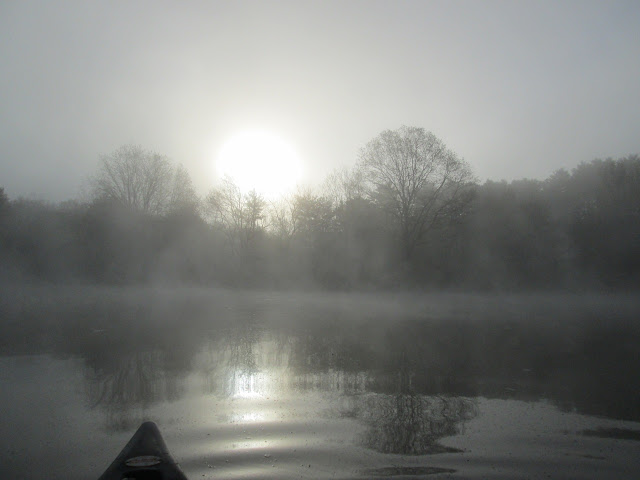Water Chestnuts
They are so pretty,
Invasive water chestnuts,
But they choke our pond.
Water chestnuts really are a pretty plant, but they spread rapidly (one rosette like the one above can create 15 or 20 seeds and each seed can produce 10-15 rosettes a year, so one seed can produce 300 new seeds!!)
Last year, our pond was harvested by a machine, and we hand pulled many canoe-loads of plants. The area that was done is MUCH better this spring. This time in 2012, it was pretty difficult to paddle on the pond, but right now, there is only one area that is choked, but it is bad.
 |
| June 6, 2013, center area of Stearns Mill Pond |
The plan for this year is to have another Pull-a-Thon on June 22, 2013, from 9:00AM-1:00PM followed by lunch. We will focus on the area around the shore where the harvester can't reach, then when the harvester comes in a couple weeks later, hopefully it can clean out the rest and in a few years our pond will be cleared of this nuisance!
We had loads of fun last year getting to know neighbors and helping our pond. Someone commented the Pull-a-Thon was better than a block party!
If you are able to participate please RSVP to Ann Kirk (abkdds@gmail.com -- this is the corrected email). We need boaters to pull and fill canoes, we need people to pull the loaded transport canoes to shore with row boats, and we need people on shore to help receive what is brought in. If you have a canoe or row boat, let Ann know. The boaters must be 14 years old or older or have a parent in the boat with the child. (more details below)
 |
| Pull-a-thon 2012 -- photo by Barbara Taskovics |
Click on the following link to find information (from Cornell University) about the Invasive Waterchestnuts, how they grow, what they look like, etc.
http://bandnotes.info/PondsWaterways/waterchestnutalert.pdf
And lastly, here is a short video of the harvester last year! (26 seconds)
DETAILS FOR SATURDAY, JUNE 22
- Please try to arrive between 8:30 and 9:00AM, sign in and get a name tag.
- At noon, BBQ for all helpers, courtesy of the Kirks
- Where: Kirk's landing - the green space at the end of the pond, on Dutton Road
- Parking: we will be parking next door to the yellow house - look for the sign.
- Bring: water boots, work gloves, sunscreen, water bottle, any recycle bins you might have--the kind with the holes in the bottom, and, your sense of humor and fun!
- Wear: old clothes (you WILL get muddy!) and a hat to shade your head, face and neck is a good idea! Tall boots, or shoes you don't mind getting wet and muddy.
- LIFE JACKETS are a must for all in canoes - our pond is muddy (2 or 3 feet deep in muck in some places) and often very shallow so that if you tipped over, you would not be able to swim; you'd just sink into the mud, like quick sand!
- Unless you are paddling to the event, we suggest you drop off your boats Friday night so that we don't have a road jam Saturday morning as everyone is trying to unload boats on narrow Dutton.
- RSVP, if you can, to Ann at abkdds@gmail.com
- Up-to-date info and news, including weather issues, on Twitter, at #StearnsMillPond
Have Fun. Get Dirty. Make a Difference. Meet Your Neighbors. Enjoy Good BBQ!







































